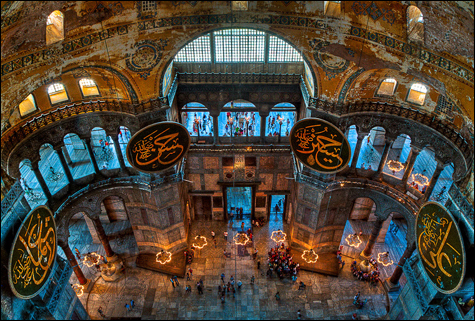
BIRD’S-EYE VIEW The perspective from the top of Hagia Sophia. |
In June 2009, A. Cemal Ekin, a marketing professor at Providence College, found himself in Istanbul, Turkey, atop scaffolding rising some 16 stories high inside the historic dome of Hagia Sophia. The 6th-century Byzantine cathedral has survived numerous changes over the years — earthquakes, looting by Crusaders in the 13th century, conversion to a mosque after Turkish conquest in 1453. It became a museum in 1934 and has been undergoing renovations for a decade and a half.
From his vertigo-inducing perch, Ekin recorded the photos in his exhibit "Touching the History," at Providence College's Hunt-Cavanagh Art Gallery (Eaton Street, Providence, through October 22). His pictures are travel calendar good. But what sets them apart is his extraordinary access, arranged by a friend. He doesn't give us an orienting view of the interior. Instead there are glimpses of the blue and gold mosaic tiles shimmering across the 108-foot-wide dome, assembling into crosses or heavenly rays or curling Arabic script. Sunlight glows through the 40 windows around the dome's base, which from the floor can make the massive brick structure seem to levitate.
That light is key — helping the structure feel airy, as well as suggesting the presence of the sacred. The spiritual and emotional power of light has long been central to holy art and architecture, as demonstrated in Linda Connor's world travel photos at the RISD Museum (through October 31) or the stained glass of Sylvia Nicolas at Providence College's Reilly Art Gallery (through October 22). Nicolas, a fourth-generation stained-glass artist based in New Hampshire, designed the 21 solemn, cartoony, folksy stained glass windows depicting the life of St. Dominic in the college's 2001 St. Dominic Chapel — which are an exemplar of Catholic art today.
Hagia Sophia hails from the period when the Catholic Church first became the preeminent patron of Western art. This began to change around the time of Rembrandt in the 17th century, as a new mercantile class began buying and commissioning art. America, though it's little noted, experienced a surge in Catholic art — often seemingly a blend of Arts and Crafts style and magazine illustration — during the church building boom of the turn of the 20th century, as parishes grew up around European immigrant communities. By mid-century, this style, with its Medieval echoes, was supplanted by abstract Modernism, like the stained-glass windows Henri Matisse designed for the 1951 Chapel of the Rosary in France and the atomic-age American churches Bauhaus alum Marcel Breuer designed in the 1950s and '60s, as an exhibit at the RISD Museum last year showed. But the fresh simplicity of their styles too often became random, simplistic abstract arrangements in others' church stained glass.
The last great Catholic artist may have been Corita Kent, a California nun who made vivid expressionist screenprints in the 1950s and religious Pop art in the '60s. She was energized when the Vatican adopted liberal policies (like offering services in local languages instead of Latin) in the early '60s, but was disheartened by the conservative retrenching that followed. She left her religious order and settled in Boston in 1968. Since then, the art world seems ever more liberal — or at least libertine — while Catholic art, like the church itself, has grown more conservative.